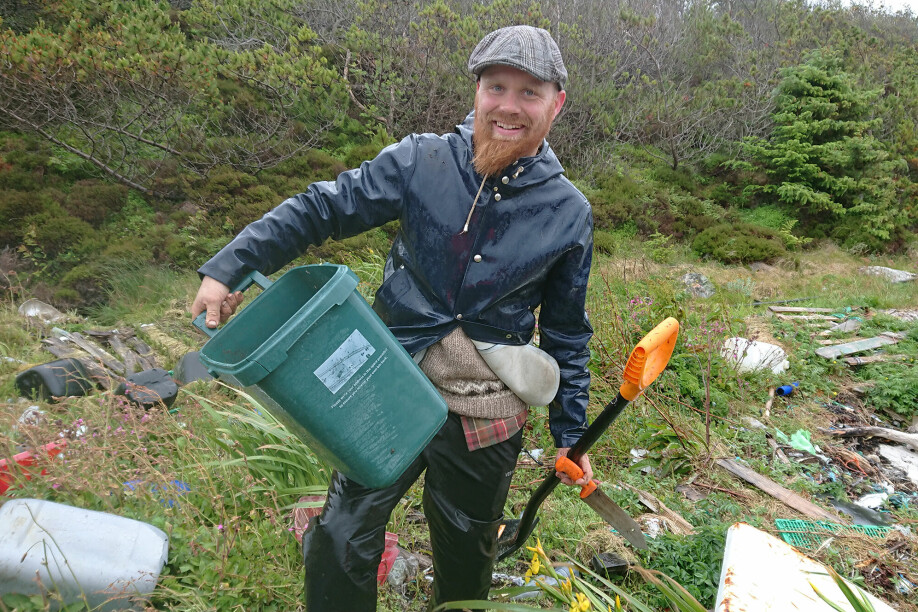
Fifty years of plastic trash hidden beneath the sod
“We had to remove a lot of vegetation to get rid of the plastic,” said one of the researchers behind a new Norwegian study.
Some of the beaches and coves along the Norwegian coast are particularly vulnerable to plastic waste. Household trash and plastics and trash from the fishing industry wash inland every year.
Norwegian researchers have investigated what has happened to two vulnerable coves — what they call wreck bays — in western Norway since the 1960s.
They found that plastic pollution had altered the landscape and plant life dramatically.
Not only is the ground covered with everything from buckets and crates to bottles and ropes — there are huge amounts of plastic hidden under the sod.

New soil between the plastic
As the researchers dug down into the plastic soil, they found that some of the trash could be dated, such as a Danish Cornflakes box from 1973.
Most of the household waste comes from Norway, Denmark and England, says Eivind Bastesen, a researcher at NORCE, one of Norway’s largest independent research institutes. He is one of the researchers behind the study, published earlier this year in the scientific journal Frontiers in Marine Science.
There was also soil between all the plastic. It appeared that the plastic had accelerated soil production.
The explanation can be that the plastic traps the marine and terrestrial plant material that is normally washed out to sea. This organic material is then turned into soil instead.

Fifteen truck loads
So how has this affected the landscape in the bays? Old aerial photographs and soil samples showed more and more accumulation of the 'plastic' soil.

The researchers estimated that the equivalent of more than nine truckloads of plastic-laden soil had accumulated on Lisle Lyngøyna, northwest of Bergen. This particular island has been called 'Skrekkøya' (Horror Island) by NRK, the Norwegian Broadcasting Corporation.
In Kolvika, which is located in Hardanger Fjord, the researchers found even more. As many as 15 truckloads of plastic-containing soil appear to have accumulated here.
A plastic skeleton
Plastic has also created another phenomenon in Kolvika.
An elongated pile of plastic and soil lies a little further inland on the beach. It’s quite common for storm surges to build these kinds of small ridges high up on the beach, but this particular ridge has grown bigger and bigger.
“What’s unnatural here is that the storm ridge is filling up with plastic. And it doesn’t break down. It’s like a plastic skeleton running along the embankment,” Bastesen said.
Environmental pollutants and microplastics leach out
Hilde Ervik, an associate professor at the Norwegian University of Science and Technology, NTNU, said the researchers’ findings are similar to what her research group has found on the islands in Frøya municipality, which is in central Norway on the outer coast.
The NTNU researchers also found large amounts of plastic under the vegetation on the eight islands they investigated.
Their research was published in May in the scientific journal Science of The Total Environment.
Ervik points out that plastic does more than simply affect the local plants and animals.
Microplastics and toxic substances from the plastic are flushed back into the sea and are taken up by everything from plankton to fish.

Appeal to the authorities
Kolavika in the Hardanger Fjord has now been cleared of plastic. An excavator and a leaf vacuum were among the tools required to make the clean-up happen.
“But this job is not nearly finished. Historically, 100 kilos of plastic rubbish washes up on land every year,” Bastesen says.
He and his colleagues plan to clean up the bay every year to see if it will return to its natural state.
Ervik believes it is important that the authorities take more responsibility for keeping beaches free from plastic, even after a beach has been cleaned up.
“What I hope comes out of this is a focus on what happens post-clearance,” she said.
Translated by Nancy Bazilchuk
Reference:
Eivind Bastesen et.al.: Rapid Landscape Changes in Plastic Bays Along the Norwegian Coastline. Frontiers in Marine Science, 2021.
———































